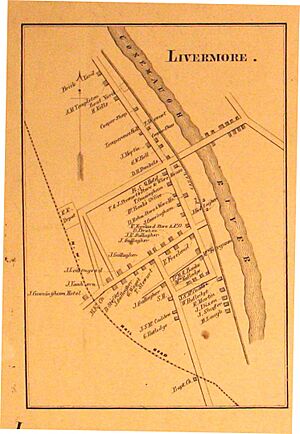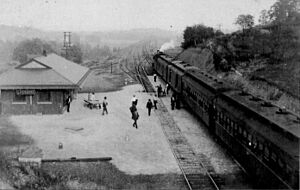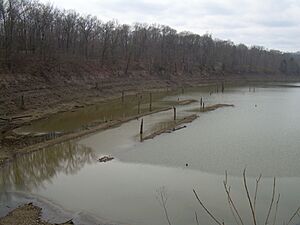Livermore, Pennsylvania facts for kids
Livermore, Pennsylvania was once a small town located next to the Conemaugh River. It was situated between Blairsville and Saltsburg in Derry Township, Westmoreland County, Pennsylvania. The town was torn down and abandoned in the early 1950s. This happened after laws were passed in 1936 and 1938 to build the Conemaugh Dam and Lake. The dam was built to stop big floods from reaching Pittsburgh. Today, much of the old town site is under the reservoir (a large artificial lake) and in areas that can flood.
Contents
A Town Lost to Water
How Livermore Started
The town of Livermore was started in 1827 by John Livermore, who named it after himself. It was built along the Conemaugh River. In 1825, the Pennsylvania government decided to build a public canal and railroad system across the state. This system was called the Pennsylvania Canal. A part of this main canal, which went from Johnstown to Pittsburgh, was built right past Livermore.
Later, in 1854, the West Penn Railroad also built tracks past Livermore. A train station was added in 1864, connecting the town to Blairsville and Saltsburg. The state sold the canal to the Pennsylvania Railroad in 1857. New train tracks were built in 1907 to make the route straighter, and a new station was built too.
Life in Livermore
As the canal grew, the town slowly got bigger. On February 13, 1865, Livermore officially became its own small town, called a borough. The Livermore Presbyterian Church started in 1851. At first, the church group didn't meet often because they didn't have enough ministers. The first church building was shared by Baptists and Presbyterians. A stronger brick church was built in 1862. By 1906, Livermore had several stores and three churches: Presbyterian, Methodist, and United Brethren. It also had one school that taught thirty-two students.
The Johnstown Flood of 1889 caused a lot of damage. It made part of the Pennsylvania Canal unusable. This cut off the western part of the canal from trade with the east. Because of this, canal towns like Livermore started to shrink.
The Big Flood of 1936
Between March 16 and 21, 1936, the smaller rivers that flow into the Allegheny and Monongahela Rivers, including the Conemaugh, flooded. This happened because of heavy rain and melting snow and ice. The ground was frozen really deep, so the water couldn't soak in. People in Livermore and other low-lying towns had to leave their homes in rowboats on the evening of March 17. Many went to higher ground in Blairsville.
This event, known as "The Great St. Patrick’s Day Flood", covered Livermore with 18 feet of water. It washed away the bridge over the Conemaugh River and fourteen buildings. Other buildings were destroyed or badly hurt. Eight homes, four properties, three barns, two garages, and all the goods in both general stores were ruined. One person died in Livermore during this flood. Overall, the flood caused about 80 deaths and over $500 million in damage across the region.
Building the Dam
After the big flood, the Flood Control Acts of 1936 and 1938 approved different projects to control floods. One of these was the Conemaugh River Dam and Lake, built nearby. This dam would protect the areas along the Conemaugh, Kiskiminetas, Allegheny, and upper Ohio River.
The dam would control how the river flows, creating an area that would flood and cover Livermore. This meant the town had to be torn down. The 57 people still living there had to move. Since it was finished in 1952, the Conemaugh River Dam has stopped over $2 billion worth of damage. For example, it prevented $375 million in damage when what was left of Hurricane Ivan hit the area in 2004.
Who Lived There?
The first time the U.S. Census counted people in small towns was in 1850. Livermore had 153 white residents in 1850, and 165 in 1860. In 1870, there were 211 people in Livermore, mostly born in the U.S. By 1880, the number dropped to 164. This was likely because the Pennsylvania Canal wasn't used as much anymore. The population went up again to 211 in 1890, but then fell to 175 in 1900. After the severe flood in 1936, only 113 people lived there in 1940, and just 57 in 1950. Soon after, the town was declared unsafe, and everyone had to leave.
Livermore Today
There are some popular stories about the old town of Livermore that might not be true. One story says the town was completely destroyed by a flood. While the area is now underwater, the buildings were actually torn down before the dam was built and the area was flooded in 1952.
Another story claims that the scary movie Night of the Living Dead was filmed at the Livermore Cemetery. But the cemetery scenes for that movie were filmed in Evans City, Pennsylvania, which is more than 60 miles away from Livermore. Still, some people think the Livermore site is haunted. These stories mostly talk about graves being moved when the town's cemetery was supposed to be moved to higher ground. However, the cemetery was never actually moved and has always been in its current spot. Because people kept damaging the cemetery, you can't visit it anymore.




